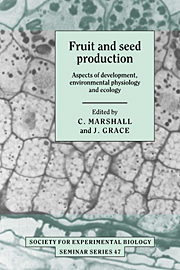Book contents
- Frontmatter
- Contents
- Contributors
- Preface
- Plant reproductive biology: an overview
- The environmental control of reproductive development
- Pollination and fertilization in higher plants
- Embryogenesis
- Environmental and internal regulation of fruiting, with particular reference to Cox's Orange Pippin apple
- Fruit growth and sink strength
- Control of grain growth and development
- The regulation of maternal investment in plants
- Ecological and physiological aspects of reproductive allocation
- Are the distributions of species determined by failure to set seed?
- Edible fruits in a cool climate: the evolution and ecology of endozoochory in the European flora
- Index
Ecological and physiological aspects of reproductive allocation
Published online by Cambridge University Press: 04 August 2010
- Frontmatter
- Contents
- Contributors
- Preface
- Plant reproductive biology: an overview
- The environmental control of reproductive development
- Pollination and fertilization in higher plants
- Embryogenesis
- Environmental and internal regulation of fruiting, with particular reference to Cox's Orange Pippin apple
- Fruit growth and sink strength
- Control of grain growth and development
- The regulation of maternal investment in plants
- Ecological and physiological aspects of reproductive allocation
- Are the distributions of species determined by failure to set seed?
- Edible fruits in a cool climate: the evolution and ecology of endozoochory in the European flora
- Index
Summary
Introduction
The pattern of resource allocation in plants and its regulation is of great practical importance to agriculturalists and horticulturalists, and is of conceptual interest to ecologists and evolutionary biologists. This chapter discusses ecological and physiological aspects of reproductive allocation and includes an approach to allocation based on plant developmental morphology; the improvement of agricultural yield in terms of increased allocation to reproductive sinks is also evaluated.
It is generally considered that nutritional and energetic resources are allocated in a strategic manner that maximizes fitness (Harper, 1977; Fitter, 1986; Bazzaz et al., 1987). Resources are allocated to three activities: growth, reproduction and defence. The inherent pattern of allocation is considered to reflect the effect of past selection pressures in optimizing both fecundity and survival. Thus genetic differences in the pattern of resource allocation tend to be broadly associated with different ecological strategies. For example, Harper (1977) has argued that in a crowded community where there will be intense competition for resources a successful individual needs vigorous shoot and root growth to maximize resource acquisition; in this case fecundity will be associated with, and depend upon, a major allocation of resources to vegetative growth. In contrast in more open environments with relatively little competition from neighbouring individuals allocation to vegetative growth becomes less important and so a large proportion of the total resource may be invested in reproductive growth and development, thereby maximizing the chance of leaving descendants.
- Type
- Chapter
- Information
- Fruit and Seed ProductionAspects of Development, Environmental Physiology and Ecology, pp. 173 - 202Publisher: Cambridge University PressPrint publication year: 1992
- 7
- Cited by



